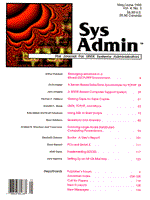
Sidebar: A Crash Course in HTML
A document written in HyperText Markup Language (HTML) is essentially a text file with some "tags" thrown in. An HTML tag is a keyword surrounded by greater-than and less-than symbols. Most tags operate in pairs, the first tag marking the beginning point of a particular effect, and the second tag marking the endpoint of this effect. Typically the ending tag is the same as the beginning tag, with a slash (/) as the first character. The tag itself is usually not case-sensitive, an exception being where a filename is being referenced, since filenames are of course case-sensitive on UNIX systems. Here is a brief list of some of the more commonly used tags: <B>,</B> -- This tag pair defines a block of text to be printed in bold type. <BODY>,</BODY> -- This tag pair defines the document's text body. <BR> -- This single tag inserts a line break in the document. <CENTER>,</CENTER> -- This tag pair defines a block of text to be centered in the window. <FORM>,</FORM> -- This tag pair marks the beginning and ending of an HTML form. See the main article for how to implement this tag set. <HR> -- This single tag inserts a horizontal line in the document. <I>,</I> -- This tag pair defines a block of text to be printed in italic type. <P> -- This single tag marks the end of a paragraph. It inserts a line break and a blank line in the document. <PRE>,</PRE> -- This tag pair indicates that everything between the beginning and ending tags has been preformatted. Usually a program displaying the document will display this text in a fixed-width courier-style font. <TITLE>,</TITLE> -- This tag pair marks a block of text to be treated as the title for a particular document. Most of the graphically based viewers display this title as the title of the window. Many of the above tags have optional modifiers which allow more control over how the tags operate. For more information on writing HTML-based forms, see the References at the end of the article.
|